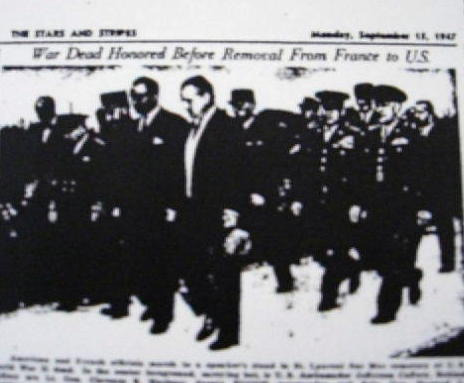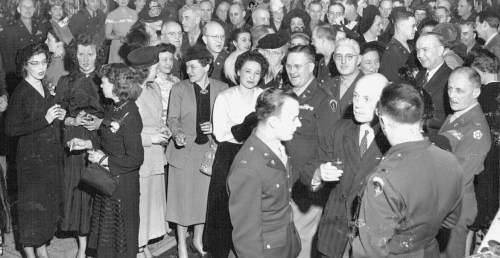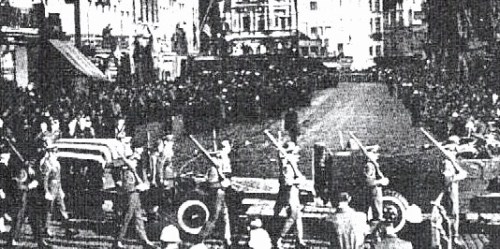The scenes on TV of young protestors marching in the streets of Iran to demand freedom and democracy remind me of the years before the Iron Curtain fell, when thousands of young people in Hungary did the same thing. Although their fight was against a harsh Communist regime, the goal was the same as that of the young people in Iran: to secure, preferably through peaceful means, the right to live in a free and democratic society.
After my father retired from the U.S. Army in 1956, he became a consultant for the Free Europe Committee (FEC). The president of the FEC at that time was retired Lt. Gen. Willis D. Crittenberger, on whose staff Dad had served at Ft. Benning in 1942. They remained good friends throughout the years, and each respected the other’s devotion to duty and country.
Excerpts from Chapter 15, “Helping to Fight Communism,” of A Salute to Patriotism: The Life and Work of Major General Howard L. Peckham
Over their vegetarian lunch, Howard Peckham and Willis Crittenberger talked about the work of the FEC, whose primary mission was helping nations held captive behind the Iron Curtain become free and independent. Dad strongly believed in the goal of this mission. It was also the main goal of the radio division, Radio Free Europe (RFE), and of the publishing division, Free Europe Press (FEP). Among its other tasks, the FEP for many years printed millions of leaflets. These messages of hope were carried by balloons from Germany and dropped into countries behind the Iron Curtain, like feathers drifting down from the wings of eagles. A peaceful end to the Communist regimes in that part of Europe, Dad believed, would be good for America’s national security and for the security of the non-Communist world as a whole.
The FEC and its FEP and RFE divisions recruited émigrés from Communist-controlled nations to write or speak in their native languages, or to serve in other significant ways. Those who worked at RFE’s New York office often created uplifting tapes about the American scene and other topics, which they sent to Munich for transmission to the captive nations.
At the end of their busy workday, the émigrés would join their countrymen in small, out-of-the-way restaurants that served such delicacies as Polish sausages, Hungarian goulash, and Czech Kolácky (prune biscuits). These tasty morsels made them feel more at home in their new environment.
During the time that Howard Peckham worked for the FEC, a prominent member of the immigrant population in New York was its senior vice president. Bernard (Bernie) Yarrow, a Columbia Law School graduate and former practicing attorney, had been in the United States ever since the 1920s.
During World War II, the Russian-born Mr. Yarrow worked for the Office of Strategic Services (OSS), predecessor of the CIA. Bernie Yarrow was a skilled intelligence officer, and in a few months, he and my father would become traveling companions on some important information-gathering trips for the FEC. In the meantime, my father’s meetings with General Crittenberger continued.
At the conclusion of the Hungarian Revolution, which began on October 23, 1956, and ended nearly a month later, Hungarian escapees arrived in droves at Camp Kilmer, a then-inactive army post located about two miles east of New Brunswick, New Jersey.
The first arrivals came in November 1956, followed by thousands more in the months to come. Some arrived in New York by ship; others by plane. Army buses brought them to Camp Kilmer, where they were billeted in wooden barracks until jobs and housing could be found for them throughout the United States.
In those years, I worked for Church World Service, a division of the National Council of Churches, in New York City. My organization set up a temporary office at the camp, where they were notified of available jobs and housing.
Church World Service received good publicity for its humanitarian efforts on behalf of the Hungarian refugees. The role of RFE, on the other hand, evoked a certain amount of media controversy in the months that followed the brutal crushing of the revolt by the Russians.
Respected CIA guru Cord Meyer, whom my father first met on a visit to the Agency’s headquarters in 1957, admits this fact in his book Facing Reality, but he also writes: “I am satisfied that RFE did not plan, direct, or attempt to provoke the Hungarian rebellion.”
Many factors entered into the failure of the revolution.
[How will events turn out in Iran? It’s anyone’s guess at this point. However, I can’t help but admire the brave young protestors who are demanding the right to live in a true democracy.]
A Salute to Patriotism: The Life and Work of Major General Howard L. Peckham is available at Amazon.com. Click here to look inside the book:
http://www.amazon.com/dp/0966585550/
Read Full Post »




